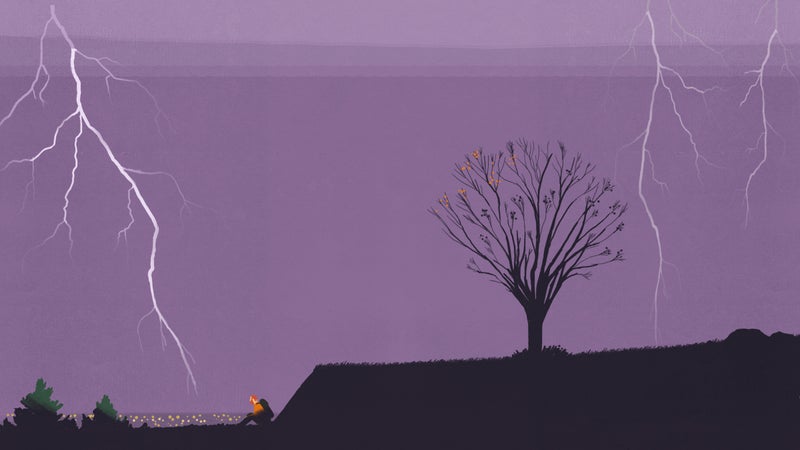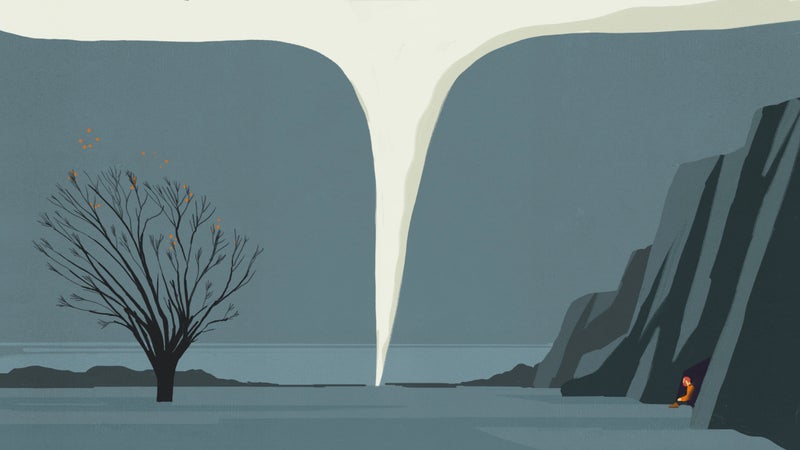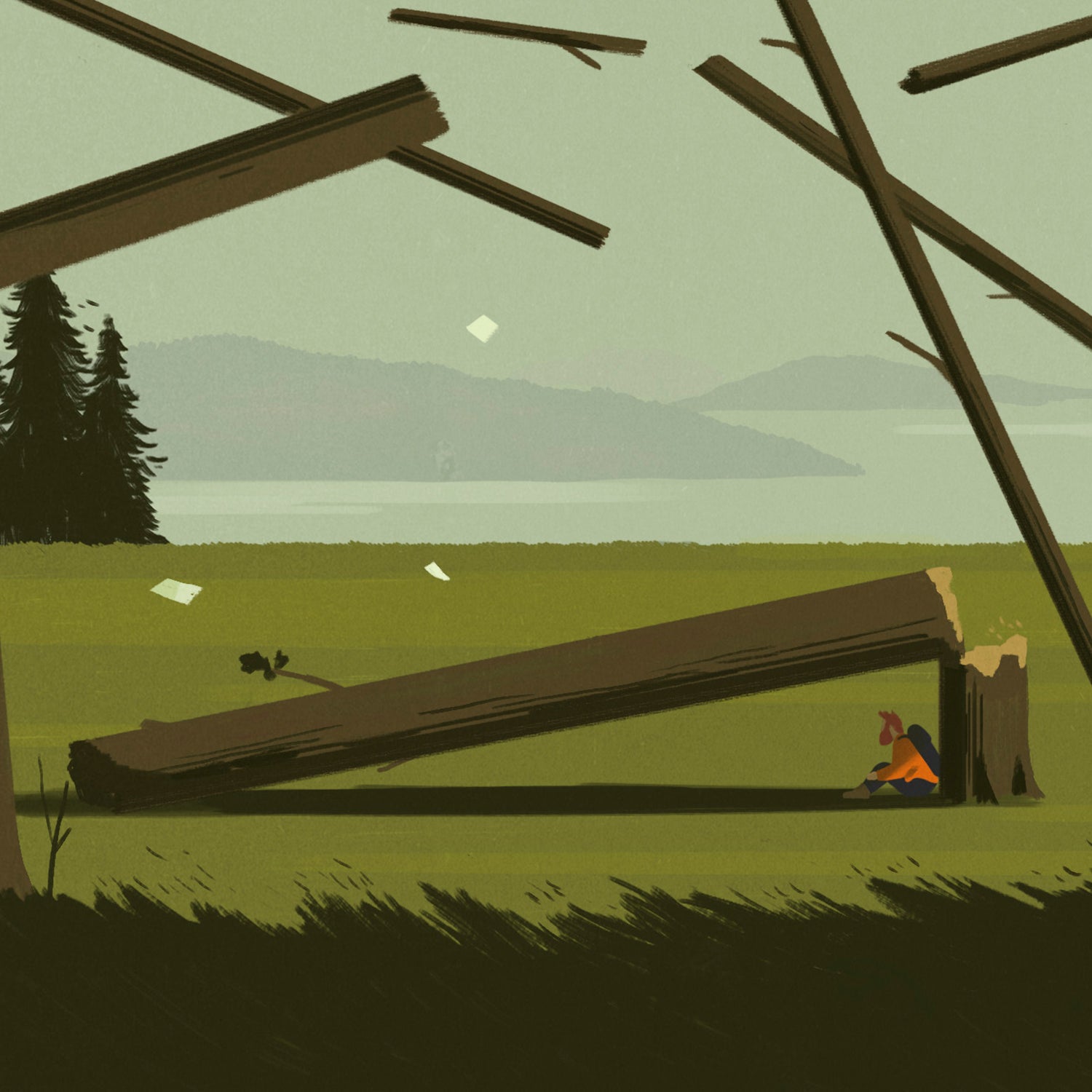Ask any local meteorologistâweather can be unpredictable. A beautiful bluebird day can quickly turn into a thunderstorm with catastrophic lightning, while blizzards and dust storms can sneak up on you like ninjas.
These severe weather events can be particularly harrowing when youâre mid-adventure. Itâs one thing to wait out a blizzard in a cabin with a wood-burning stove, but what about when youâre backcountry skiing? Or a dust storm approaches at 30 miles per hour while youâre hiking in the desert? Or a thunderstorm pops up just as you summit a peak?
To help, we talked to weather and survival experts to learn best safety practices for when youâre stuck outside during extreme weather events.
Thunderstorm

Youâre likely to encounter a thunderstorm at least once during your outdoor adventuring. the National Oceanic and Atmospheric Administration (NOAA), at any given moment in the day, there are roughly 2,000 thunderstorms in progress across the globe. The United States experiences 100,000 thunderstorms every year, with spring and summer afternoons seeing the highest frequency of events. Each storm can bring a suite of problems, from hail to high winds, but itâs lightning that is your number one concern.
The smartest way to avoid lightning is to stay inside. But it may be tough to find a good place on the trail when there are no buildings nearby, according to John Gookin, who taught safety courses for the National Outdoor Leadership School (NOLS) for 39 years and wrote the backcountry lightning safety measures for NOAA. Still, that doesnât mean youâre helpless. âIf you see a thunderstorm forming, get off the mountaintop, fast,â Gookin says, adding that higher elevations attract more lightning strikes. Move off ridgelines and find a gully or ravine; also avoid standing at the base of tall, isolated trees, which tend to attract lightning.
Remember that the majority of lightning injuries donât come from aboveâthey come from ground currents, when electricity from a strike travels through the ground and up and out of another conductor. You can minimize a ground currentâs damage by minimizing your contact with the earth. Keep your feet together and your hands close to your sides so that, if youâre struck, the charge can move through you quickly. According to Gookin, it doesnât matter if youâre in a crouching position or standing straight up. The key is to just keep your limbs in tight. (Although some people think standing on a sleeping pad helps because it adds a layer between you and the ground, Gookin says thereâs no proof to that theory. Still, he also says it wonât hurt matters, so itâs OK to do it if it makes you more comfortable.)
Gookin says the old trick of counting between lightning strikes and thunder is actually a good indicator of the strikeâs distanceâfor every five seconds between the two, the storm is one mile away. But if youâre in an area with cell service, he prefers to rely on , an app that maps every lightning strike in the country in real time.
Blizzard

Blizzards are a classic example of too much of a good thing, too fast, causing visibility issues that can create problems when skiers try to get back to their car or hut from the backcountry.
âWinter is our busy season from a rescue standpoint,â says Cody Lockhart, chief adviser with Teton County Search and Rescue in Wyoming. âMost of our rescues are people overnighted unexpectedly. Theyâre more urgent because of the weather. The consequences are high.â
Lockhart says being prepared for a blizzard starts at home with an emergency kit that includes extra layers, a solid GPS app (see below), a light tarp you can use for shelter, and a simple fire kit. He has a baggie with a lighter and a in every pair of snow pants he owns. âIf you can start a fire, spending the night out in a blizzard isnât unpleasant,â he says.
He also says to trust your instinct when deciding to return to your car or hut, as long as you have some visibility and a GPS plot your route. He likes the , which has replaced stand-alone GPS units for his search and rescue team. But if you arenât certain how to get back to safety, and poor visibility will only result in you getting more lost, itâs time to build a shelter.
You can carve out a snow cave if you have toâsimply dig a tunnel and bell-shaped area into the snow (this will help prevent it from caving in) and clear enough ground outside of the tunnel for a fireâbut youâre better off finding a deep tree well and clearing the excess snow from one side of the tree. If you have a light tarp, stretch it over ski poles or branches for a roof. Then, build a fire using any dead wood you can find. âWood thatâs been snowed on isnât as wet as wood thatâs been rained on. It will burn,â Lockwood says, adding that your fire should be big. âMost importantly, try to stay mentally strong. Keep reminding yourself that you can get through the night. Being positive is as important as being prepared with the right gear. The will to survive is a real thing. It can get you through.â
°ŐŽÇ°ùČÔČč»ćŽÇÌę

A certain stretch of the Midwest known as Tornado Alley, which stretches from mid-Texas up to North Dakota, is plagued by a high frequency of tornadoes. But the disastrous storms arenât just relegated to the plains. âTornadoes can happen anywhere,â says Richard Smith, a warning coordinator with NOAA. He adds that the twisters are often tens of thousands of feet tall, so what we see on the surface is just the bottom tip of the storm. âTornados donât care if there are mountains or towns or skyscrapers in their way.â
While tornadoes can form quicklyâon average, NOAA releases a tornado warning in the potential impact area 15 minutes before the tornado hitsâmost twisters are born from thunderstorms. So, if youâre on a trail and a thunderstorm turns from bad to worseâthink: hail, excessive lightning, high windsâconsider the worsening weather as your advanced tornado warning. If you grew up with tornado drills, then you know the routine: head to the basement, and duck and cover. Your options are more limited if youâre hiking in a forest.
âThere are no perfect options at that point,â Smith says. But youâre not completely helpless. According to Smith, donât worry about being sucked into a tornado, which is rare. Instead, most injuries come from the wreckage thatâs flying through the air. âYour goal is to try to get as low as you can and put as many barriers between you and the debris.â
Get off the top of the mountain, find a ditch, ravine, or cave, and shield yourself, putting on all the layers in your pack and a helmet if you have one with you. Then get into the duck-and-cover position, shielding the back of your head with your hands, and use your pack as a guard while you wait for the weather to clear up.
Flash Flood

The severity and speed of flash floods make them one of the most harrowing weather events adventurers might encounter. They occur when excessive water fills normally dry canyons or when creeks and rivers rise rapidly from rainfall within their watershed. Canyoners are constantly concerned about flash floods, but hikers exploring riverside trails and narrow gorges should also be aware of flood potential, because they can happen with little to no warning. According to the National Severe Storms Laboratory, a creek thatâs only six inches deep in the mountains can swell to a ten-foot-deep raging river in less than an hour if a thunderstorm lingers over an area for an extended period of time.
âI have witnessed many flash floods, some small and some massive,â says Rick Green, an instructor and certified master guide with the American Canyoneering Association. âThe common theme in all of these has been how quickly they happen and how little water is required to create a powerful and dynamic flow.â
Green says begins at home by watching a variety of weather reports for the area surrounding the canyon or hike youâre going to explore. He likes the at Weather.gov, which gives a big-picture view of the weather in a certain area, indicating how much water is contained in the cloud cover. But if youâre caught in a gorge during a flood, your number one priority is finding high ground, fast.
âMost flooding I have seen appeared very similar to a tsunami overtaking land,â Green says. âThereâs not a physical âwallâ of water, but a leading edge that can build to full depth in as little as 60 seconds.â
Once you experience this flooding, your only hope is to climb above it. Mark exits, or paths that lead to the top of the chasm on your map before you enter the canyon, and make mental notes of high groundâledges that are above potential high-water linesâand exits as you move through the gorge, pointing them out to your team along the way.
âRunning and âlookingâ for your exit is no fun,â Green says. âIf you hurt yourself while rushing, things will likely get much worse. Stay ahead of the game by being prepared.â
Dust Storm

Dust storms are straight out of the movies: a wall of sand, several stories high, moving through a landscape at speeds up to 50 miles per hour. Technically, they are called âhaboobs,â a term that originated in the Middle East, where the events are more common, but they can occur in any arid landscape. Arizona, in particular, sees its share of haboobs, which typically form when a thunderstorm collapses and produces a gust of wind that collects and moves dust along the terrain. Waiting out a dust storm from a car or house is annoying but relatively safe. But hiking or biking through a dust storm is a different story, as visibility is reduced drastically, and sand and debris flying through the air can cause serious damage to your skin, eyes, and lungs. If you canât find shelter, your only option is to hunker down and wait it out.
âFind the downwind side of a boulder, and cover as much of your skin as you can,â says Kirstin Peterson, owner of Rim Mountain Bike Tours. Peterson regularly deals with high-wind events in the desert outside her home in Moab and is always prepared for full-on haboobs when she guides in Arizona. âDealing with that wind, and the sand pelting you, it feels like youâre being ripped apart.â
Peterson says you can give yourself the best chance at coming out of a dust storm unscathed by packing a long-sleeve shirt, a neck tube, which you can pull over your face and ears, and a pair of ski goggles. âIt sounds crazy to take ski goggles into the desert, but those goggles will be your best friend during a dust storm,â she says.
Put on your protective gear as soon as you see the wind kicking up, crouch behind a boulder, covering your head with your hands, and wait until the dust settles. If thereâs no boulder, get into a defensive crouch, putting your head in your hands and pulling your backpack up to cover the back of your head and neck.


